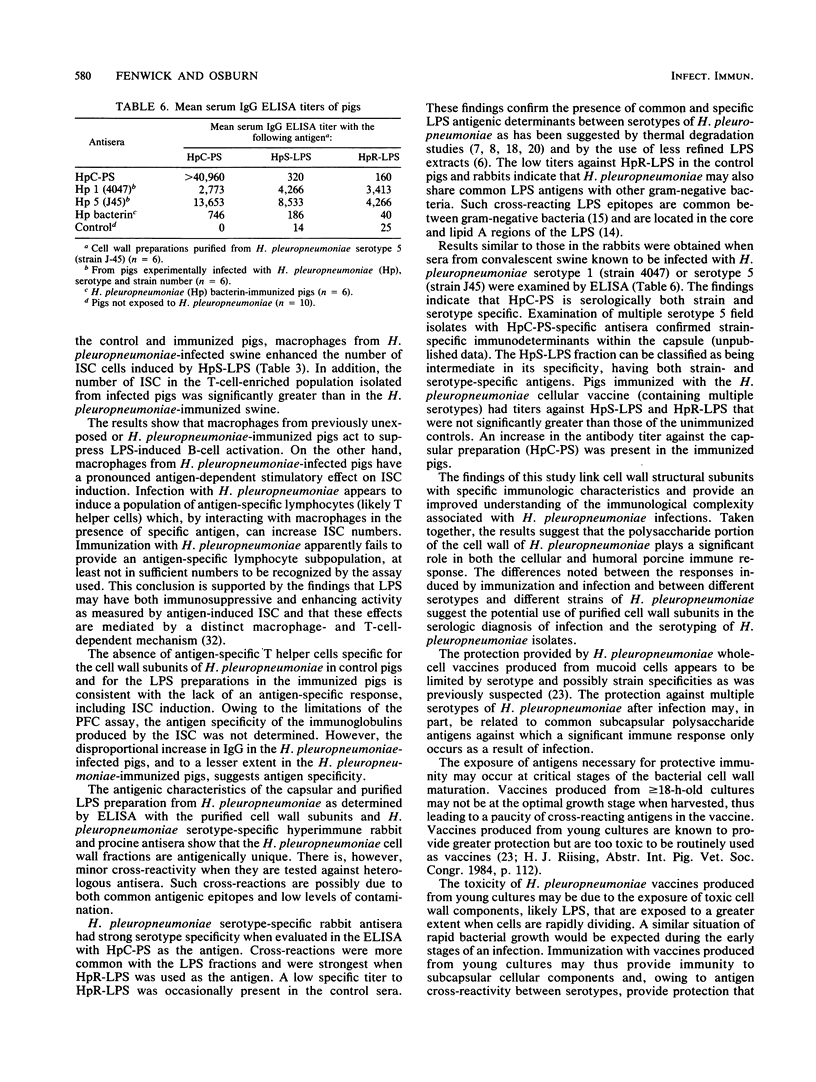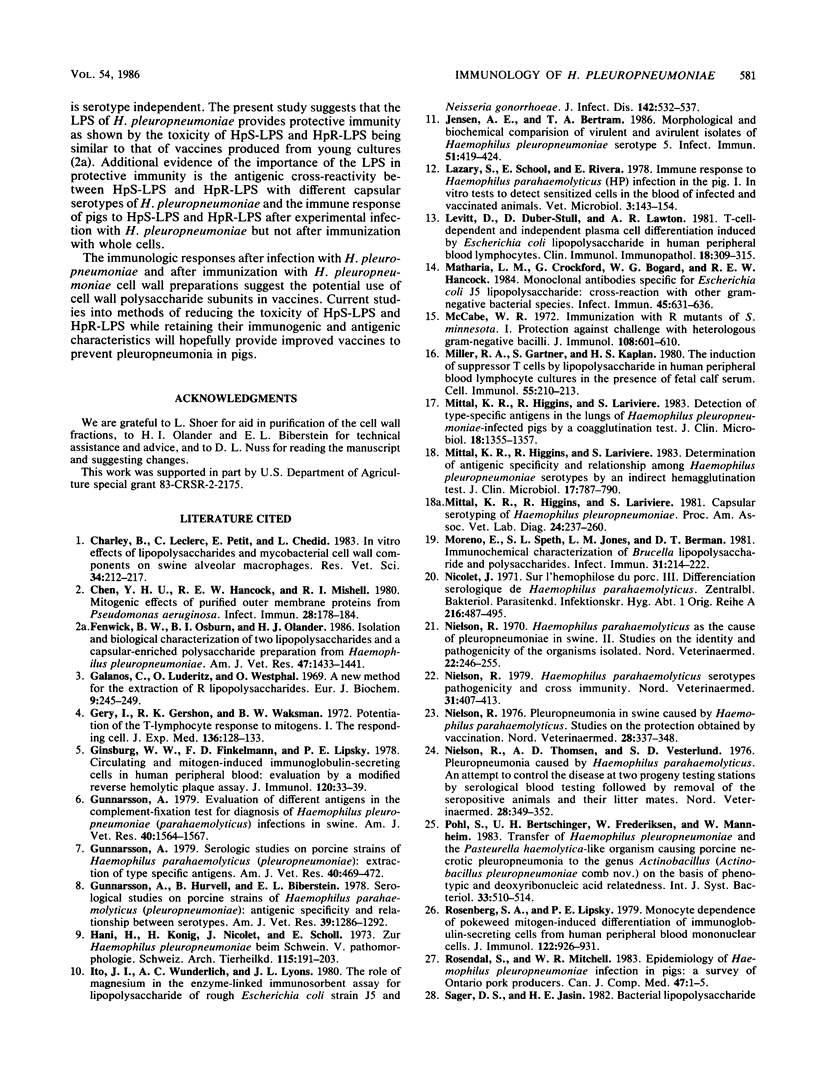Abstract
The immunologic responses to a smooth-type lipopolysaccharide (LPS) (HpS-LPS), a rough-type LPS (HpR-LPS), and a capsular-enriched polysaccharide preparation (HpC-PS) purified from Haemophilus pleuropneumoniae were determined in pigs immunized with a commercial H. pleuropneumoniae cellular vaccine, in pigs experimentally infected with H. pleuropneumoniae, in control pigs, and in immunized rabbits. The ability of the preparations to induce lymphocyte blastogenesis and B-cell activation was determined in the pigs and compared with the responses induced by the LPS of Escherichia coli O111:B4 and the LPS of Salmonella minnesota Re595. All the LPS preparations acted to induce proliferation of peripheral blood lymphocytes (PBL) from all pigs. The blastogenic response of PBL from H. pleuropneumoniae-infected pigs to HpS-LPS and HpR-LPS was significantly (P less than 0.05) greater than that of PBL from immunized and control pigs. HpC-PS did not induce a blastogenic response in the PBL of control pigs but did in PBL from H. pleuropneumoniae-infected pigs and to a greater degree in immunized pigs. An increase in the response of PBL to the S. minnesota LPS occurred only in the H. pleuropneumoniae-infected pigs. Significantly more (P less than 0.05) immunoglobulin-secreting cells (ISC) were induced in a reverse hemolytic plaque assay by stimulation with HpS-LPS and HpC-PS of PBL isolated from pigs infected with H. pleuropneumoniae than of PBL from immunized pigs. Increasing the number of T cells increased the number of ISC induced by HpS-LPS in control and immunized pigs, but not in convalescent pigs. The presence of macrophages reduced activation of ISC by HpS-LPS in control pigs and to a lesser degree in immunized pigs, whereas in H. pleuropneumoniae-infected pigs macrophages enhanced the induction of ISC by HpS-LPS. In immunized pigs, macrophages acted to inhibit the ability of HpC-PS to induce ISC. Serologic studies indicate that HpC-PS contains strain- and serotype-specific antigens; that HpS-LPS has both serotype-specific and cross-reacting species-specific antigens; and that HpR-LPS does not contain detectable serotype-specific antigens but does have both non species- and species-specific antigens. These studies show that the serotype-specific protection provided by immunization of pigs with an H. pleuropneumoniae cellular vaccine is principally the result of immunity to capsular antigens and that a weak cellular immune response occurs as compared with that induced by infection with H. pleuropneumoniae.(ABSTRACT TRUNCATED AT 400 WORDS)
Full text
PDF







Selected References
These references are in PubMed. This may not be the complete list of references from this article.
- Charley B., Leclerc C., Petit E., Chedid L. In vitro effects of lipopolysaccharides and mycobacterial cell wall components on swine alveolar macrophages. Res Vet Sci. 1983 Mar;34(2):212–217. doi: 10.1016/S0034-5288(18)32262-8. [DOI] [PMC free article] [PubMed] [Google Scholar]
- Chen Y. H., Hancock R. E., Mishell R. I. Mitogenic effects of purified outer membrane proteins from Pseudomonas aeruginosa. Infect Immun. 1980 Apr;28(1):178–184. doi: 10.1128/iai.28.1.178-184.1980. [DOI] [PMC free article] [PubMed] [Google Scholar]
- Fenwick B. W., Osburn B. I., Olander H. J. Isolation and biological characterization of two lipopolysaccharides and a capsular-enriched polysaccharide preparation from Haemophilus pleuropneumoniae. Am J Vet Res. 1986 Jul;47(7):1433–1441. [PubMed] [Google Scholar]
- Galanos C., Lüderitz O., Westphal O. A new method for the extraction of R lipopolysaccharides. Eur J Biochem. 1969 Jun;9(2):245–249. doi: 10.1111/j.1432-1033.1969.tb00601.x. [DOI] [PubMed] [Google Scholar]
- Gery I., Gershon R. K., Waksman B. H. Potentiation of the T-lymphocyte response to mitogens. I. The responding cell. J Exp Med. 1972 Jul 1;136(1):128–142. doi: 10.1084/jem.136.1.128. [DOI] [PMC free article] [PubMed] [Google Scholar]
- Ginsburg W. W., Finkelman F. D., Lipsky P. E. Circulating and mitogen-induced immunoglobulin-secreting cells in human peripheral blood: evaluation by a modified reverse hemolytic plaque assay. J Immunol. 1978 Jan;120(1):33–39. [PubMed] [Google Scholar]
- Gunnarsson A. Evaluation of different antigens in the complement-fixation test for diagnosis of Haemophilus pleuropneumoniae (parahaemolyticus) infections in swine. Am J Vet Res. 1979 Nov;40(11):1564–1567. [PubMed] [Google Scholar]
- Gunnarsson A., Hurvell B., Biberstein E. L. Serologic studies of porcine strains of Haemophilus parahaemolyticus (pleuropneumoniae): antigenic specificity and relationship between serotypes. Am J Vet Res. 1978 Aug;39(8):1286–1292. [PubMed] [Google Scholar]
- Gunnarsson A. Serologic studies on porcine strains of Haemophilus parahaemolyticus (pleuropneumoniae): extraction of type-specific antigens. Am J Vet Res. 1979 Apr;40(4):469–472. [PubMed] [Google Scholar]
- Häni H., König H., Nicolet J., Scholl E. Zur Haemophilus-Pleuropneumonie beim Schwein. V. Pathomorphologie. Schweiz Arch Tierheilkd. 1973 May;115(5):191–203. [PubMed] [Google Scholar]
- Ito J. I., Jr, Wunderlich A. C., Lyons J., Davis C. E., Guiney D. G., Braude A. I. Role of magnesium in the enzyme-linked immunosorbent assay for lipopolysaccharides of rough Escherichia coli strain J5 and Neisseria gonorrhoeae. J Infect Dis. 1980 Oct;142(4):532–537. doi: 10.1093/infdis/142.4.532. [DOI] [PubMed] [Google Scholar]
- Jensen A. E., Bertram T. A. Morphological and biochemical comparison of virulent and avirulent isolates of Haemophilus pleuropneumoniae serotype 5. Infect Immun. 1986 Feb;51(2):419–424. doi: 10.1128/iai.51.2.419-424.1986. [DOI] [PMC free article] [PubMed] [Google Scholar]
- Levitt D., Duber-Stull D., Lawton A. R. T-cell-dependent and independent plasma cell differentiation induced by Escherichia coli Lipopolysaccharide in human peripheral blood lymphocytes. Clin Immunol Immunopathol. 1981 Mar;18(3):309–321. doi: 10.1016/0090-1229(81)90124-0. [DOI] [PubMed] [Google Scholar]
- McCabe W. R. Immunization with R mutants of S. Minnesota. I. Protection against challenge with heterologous gram-negative bacilli. J Immunol. 1972 Mar;108(3):601–610. [PubMed] [Google Scholar]
- Miller R. A., Gartner S., Kaplan H. S. The induction of suppressor T cells by lipopolysaccharide in human peripheral blood lymphocyte cultures in the presence of fetal calf serum. Cell Immunol. 1980 Sep 15;55(1):210–218. doi: 10.1016/0008-8749(80)90152-5. [DOI] [PubMed] [Google Scholar]
- Mittal K. R., Higgins R., Lariviere S. Determination of antigenic specificity and relationship among Haemophilus pleuropneumoniae serotypes by an indirect hemagglutination test. J Clin Microbiol. 1983 May;17(5):787–790. doi: 10.1128/jcm.17.5.787-790.1983. [DOI] [PMC free article] [PubMed] [Google Scholar]
- Mittal K. R., Higgins R., Larivière S. Detection of type-specific antigens in the lungs of Haemophilus pleuropneumoniae-infected pigs by coagglutination test. J Clin Microbiol. 1983 Dec;18(6):1355–1357. doi: 10.1128/jcm.18.6.1355-1357.1983. [DOI] [PMC free article] [PubMed] [Google Scholar]
- Moreno E., Speth S. L., Jones L. M., Berman D. T. Immunochemical characterization of Brucella lipopolysaccharides and polysaccharides. Infect Immun. 1981 Jan;31(1):214–222. doi: 10.1128/iai.31.1.214-222.1981. [DOI] [PMC free article] [PubMed] [Google Scholar]
- Mutharia L. M., Crockford G., Bogard W. C., Jr, Hancock R. E. Monoclonal antibodies specific for Escherichia coli J5 lipopolysaccharide: cross-reaction with other gram-negative bacterial species. Infect Immun. 1984 Sep;45(3):631–636. doi: 10.1128/iai.45.3.631-636.1984. [DOI] [PMC free article] [PubMed] [Google Scholar]
- Nicolet J. Sur l'hémophilose du pore. 3. Différenciation sérologique de Haemophilus parahaemolyticus. Zentralbl Bakteriol Orig. 1971;216(4):487–495. [PubMed] [Google Scholar]
- Nielsen R., Thomsen A. D., Vesterlund S. D. Pleuropneumonia caused by Haemophilus parahaemolyticus. An attempt to control the disease at two progeny testing stations by serological blood testing followed by removal of the seropositive animals and their litter mates. Nord Vet Med. 1976 Jul-Aug;28(7-8):349–352. [PubMed] [Google Scholar]
- Rosenberg S. A., Lipsky P. E. Monocyte dependence of pokeweed mitogen-induced differentiation of immunoglobulin-secreting cells from human peripheral blood mononuclear cells. J Immunol. 1979 Mar;122(3):926–931. [PubMed] [Google Scholar]
- Rosendal S., Mitchell W. R. Epidemiology of Haemophilus pleuropneumoniae infection in pigs: a survey of Ontario Pork Producers, 1981. Can J Comp Med. 1983 Jan;47(1):1–5. [PMC free article] [PubMed] [Google Scholar]
- Sager D. S., Jasin H. E. Bacterial lipopolysaccharide-induced immunoglobulin synthesis by human blood lymphocytes partially depleted of monocytes. Clin Exp Immunol. 1982 Mar;47(3):645–652. [PMC free article] [PubMed] [Google Scholar]
- Schultz R. A., Young T. F., Ross R. F., Jeske D. R. Prevalence of antibodies to Haemophilus pleuropneumoniae in Iowa swine. Am J Vet Res. 1982 Oct;43(10):1848–1851. [PubMed] [Google Scholar]
- Zabala C., Lipsky P. E. Immunomodulatory effects of bacterial lipopolysaccharide on human B lymphocyte activation in vitro. J Immunol. 1982 Dec;129(6):2496–2503. [PubMed] [Google Scholar]


